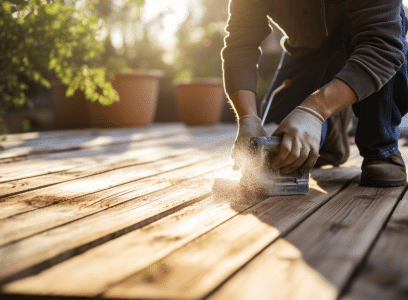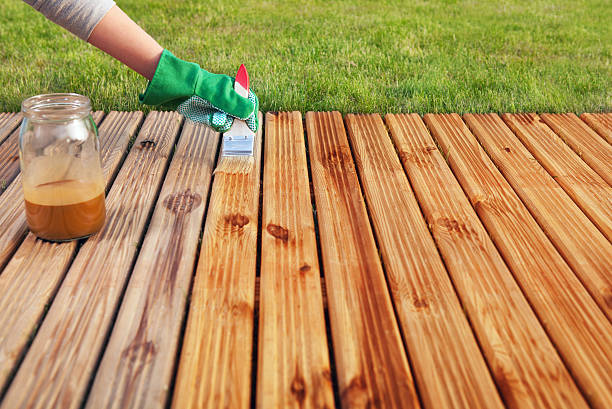Reliable Fence Cleaning Near Me: Top quality Ensured
Deck Staining 101: Everything You Required to Know for a DIY Project
From preparing the deck surface to picking the appropriate kind of stain and understanding the application methods, each action plays a vital duty in attaining a specialist surface. Join us as we untangle the vital standards and insider ideas for mastering the art of deck discoloration, ensuring an effective Do it yourself job that will certainly leave your deck looking remarkable.
Relevance of Deck Staining
Deck discoloration is a crucial maintenance job that maintains the long life and look of outdoor wood structures. By using a layer of stain to the deck's surface, you develop a protective obstacle that helps prevent moisture penetration, UV damages, and deteriorating of the timber.
Furthermore, deck discoloration improves the natural appeal of the timber by highlighting its grain and texture. It offers a possibility to customize the appearance of the deck by selecting from a selection of tarnish surfaces and shades. Whether you like a clear tarnish that showcases the timber's natural color or a strong stain that adds a pop of shade, the ideal tarnish can elevate the general aesthetic of your outside home. In essence, routine deck discoloration is a simple yet effective way to guarantee your deck continues to be structurally sound and aesthetically pleasing for many years ahead.
Deck Preparation Steps

After cleansing and repairing, sanding the deck is required to smooth out rough surface areas and open up the wood's pores to far better take in the tarnish. When the deck is clean, completely dry, and smooth, protect any type of neighboring plants, furnishings, or surface areas with a decline towel before using the deck tarnish.
Picking the Right Discoloration
Selecting the suitable discolor for your deck is an essential choice that straight impacts both its look and durability. When picking the ideal tarnish, there are a number of aspects to take into consideration to ensure an effective DIY job.
To start with, you need to decide in between clear, semi-transparent, and solid stains. Clear stains permit the natural grain of the wood to show through but use very little security against UV navigate here rays and dampness. Semi-transparent stains offer a concession between color and defense, while strong discolorations offer the most defense however cover the timber grain.
Next, consider the kind of wood your deck is constructed from, as various stains work much better with particular timber species. For cedar, redwood and instance decks often look finest with a semi-transparent or clear tarnish to highlight their natural elegance. Pressure-treated timber could gain from a strong stain to conceal blemishes.
Lastly, consider the climate in your location. If you experience extreme winters months or intense sunlight, select a tarnish with UV protection and resistance to severe weather. By meticulously considering these aspects, you can pick a tarnish that enhances your deck's looks and durability.

Using Stain Properly
When taking into consideration the application of tarnish to your deck, it is necessary to pay close interest to the particular features of the tarnish selected and exactly how it interacts with the type of wood and environmental problems formerly pondered. Before beginning the discoloration process, ensure that the deck surface is clean, dry, and devoid of any previous coverings or particles. It is recommended to test the picked tarnish on a little low-profile location of the deck to guarantee compatibility and achieve the preferred shade and finish.
Apply the tarnish along the length of the deck boards to prevent unequal pooling - fence cleaning near me. It is critical to work with the timber grain to improve the all-natural charm of the deck and fence company va allow for better infiltration of their website the tarnish.
Upkeep and Treatment Tips

Another critical aspect of deck maintenance is shielding it from the elements. Regularly trimming nearby vegetation can also avoid leaves and branches from building up on your deck and triggering prospective damage.
Conclusion
Finally, deck staining is an important step in keeping the look and durability of your outside space. By properly preparing the deck, choosing the appropriate tarnish, using it correctly, and following upkeep pointers, you can make sure a resilient and gorgeous finish that will certainly last for many years to come. Bear in mind to regularly evaluate and care for your discolored deck to keep it looking its ideal.
Join us as we decipher the important guidelines and expert suggestions for mastering the art of deck discoloration, making sure a successful Do it yourself job that will leave your deck looking impeccable. - deck staining near me
In significance, routine deck staining is a straightforward yet reliable method to ensure your deck continues to be structurally sound and visually pleasing for years to come.
As soon as the deck is clean, completely dry, and smooth, shield any type of nearby plants, furnishings, or surfaces with a decline cloth prior to applying the deck discolor.Following, think about the kind of wood your deck is made of, as different stains function much better with certain timber varieties.When thinking about the application of tarnish to your deck, it is important to pay close interest to the details qualities of the tarnish chosen and exactly how it connects with the type of timber and ecological conditions formerly deliberated.